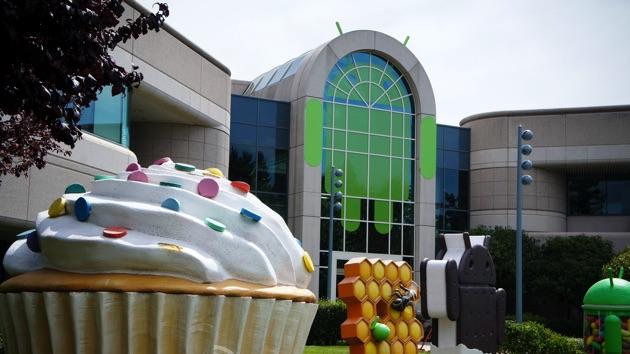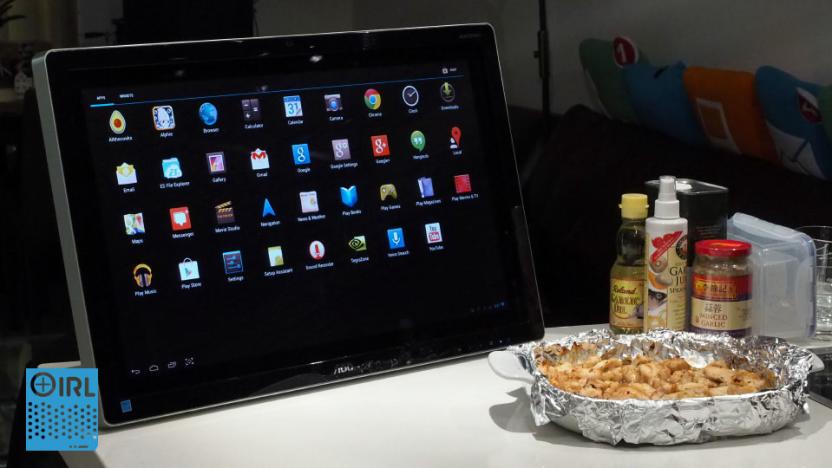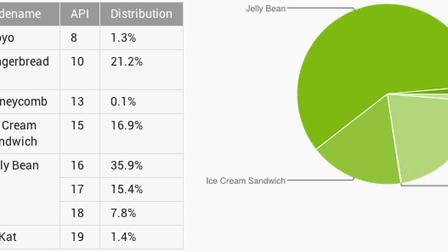jellybean
Latest

Marshmallow is now on 10 percent of Android devices
The latest version of Android just hit a big, big milestone. Google's early June developer stats have revealed that Marshmallow is now on just over 10 percent of Android devices, representing a huge jump from just 2.3 percent in March. Notably, only some of that surge can be credited to people upgrading from Lollipop. While the not-quite-current version's adoption did go down (to 35.4 percent), the biggest declines in usage were for Jelly Bean and KitKat. In essence: many of those moving to Marshmallow may well have been replacing devices that were 3 or more years old.
Jon Fingas06.07.2016
Lollipop becomes the most popular version of Android
At last, there's a new flavor of Android on top of the heap. Google has published updated stats which show that Lollipop is now the most-used version of Android, snagging 36.1 percent of device share in early March versus former champ KitKat's 34.3 percent. It's a big milestone that suggests many Android users are using a reasonably modern take on the mobile platform.
Jon Fingas03.08.2016
Nearly a quarter of Android users are running Lollipop
Android Lollipop is enjoying its last, shining moment in the sun before Marshmallow arrives in earnest. Google's not-quite-current operating system now accounts for 23.5 percent of active Android users, a healthy 2.5-point boost from what you saw just one month ago. That's still trailing behind Jelly Bean (30.2 percent) and KitKat (38.9 percent), but it's clear that all those new devices and upgrades are starting to add up. The real question is whether or not that momentum will last. Marshmallow is arriving relatively quickly, and shouldn't suffer from the early performance and battery life woes that kept some people from upgrading last year. If the newer release catches on quickly, Lollipop might not reach the lofty adoption rates of its predecessors.
Jon Fingas10.07.2015
Android Lollipop is slowly (very slowly) hitting more devices
Lollipop didn't exactly take the Android world by storm when it first launched. Early adoption was slow enough that it made no real impact in usage share stats for the first couple of months. People are starting to take to Google's latest dessert-flavored OS, however -- it's finally on the official radar. Google's data now shows that about 1.6 percent of active Android users were using Lollipop as of the start of February. That's certainly not a lot, but it's clear that all those Nexuses and early Lollipop upgrades (most notably from HTC, LG and Motorola) count for something.
Jon Fingas02.02.2015
Google explains why it's not fixing web security in old Android phones
You might not be happy that Google isn't fixing a web security flaw in your older Android phone, but the search giant now says that it has some good reasons for holding off. As the company's Adrian Ludwig explains, it's no longer viable to "safely" patch vulnerable, pre-Android 4.4 versions of WebView (a framework that lets apps show websites without a separate browser) to prevent remote attacks. The sheer amount of necessary code changes would create legions of problems, he claims, especially since developers are introducing "thousands" of tweaks to the open source software every month.
Jon Fingas01.24.2015
Lollipop isn't making a dent in Android usage numbers (yet)
Now that Android 5.0 Lollipop is finally rolling out to devices around the globe, you might be wondering just how much of an impact it's making on the Android ecosystem. The short answer: not much. Google has released its latest Android usage stats, and Lollipop doesn't even register yet -- in other words, less than 0.1 percent of Google Play users have moved to the new software. That's not surprising given that both the upgrade and Lollipop-native devices like the Nexus 6 are weeks old at best, but it suggests that the new OS will take a while before it makes its presence known.
Jon Fingas12.01.2014
HP SlateBook 14 review: Android? On a laptop?
There's mounting evidence that HP, once the leading PC maker, does not know what it's doing. After announcing plans to cut up to 5 percent of its work force, the company is basically throwing stuff at the wall and seeing what sticks. Recent experiments include a luxury smartwatch, Chromebooks, a $199 Window notebook and now, a laptop running Android. Here's the sales pitch, and bear with me if this doesn't make sense: The SlateBook 14, according to HP, is for students and teens who already use Android on their mobile devices. In other words, they already own a Galaxy S5 or what have you, and they should have an Android laptop to match. The idea is that they might choose this over a Chromebook because it has more apps, and because it's more familiar. Ditto for Windows laptops -- except, you know, Windows actually has lots of apps too. Setting aside HP's flawed logic (they never said Windows users should stick to Windows Phone): Why would you pay $430 for a laptop running an OS that was primarily meant to be used with the fingers?
Dana Wollman08.21.2014
KitKat is now running on more than 20 percent of Android devices
In case there was any doubt that KitKat now has a solid foothold in the Android world, Google just offered some proof. Its usage data for early August shows that KitKat is on more than a fifth of active Android devices, at 20.9 percent. That's a healthy improvement over July (17.9 percent), and a big leap over the 14.9 percent we saw in June. The folks in Mountain View aren't explaining the steady growth, but it's easy to figure out what's going on -- big-name devices like the LG G3 and Samsung Galaxy Tab S are bringing this latest OS flavor to a wider audience, and many older gadgets are still getting upgrades.
Jon Fingas08.13.2014
IRL: A 24-inch AOC monitor that doubles as a gigantic Android tablet
What can you do with 24 inches of Jelly Bean that you can't do with 10? Manufacturers like Acer, Asus and ViewSonic have been building oversized Android-powered devices for a couple years now; I was determined to find out why, so I spent a few weeks with AOC's own all-in-one. The hybrid external monitor will run you $370 on Amazon -- more than twice what you'll pay for a comparable 1080p screen -- but this pricier model adds stock Android 4.2.2 with a touchscreen interface. With the tap of a button, the integrated quad-core processor and eight gigs of storage spring into action, effectively converting this otherwise ordinary monitor into a complete Android-powered machine. There's even an integrated 720p webcam, and with stock Jelly Bean on board, you can install whatever apps you'd like from Google Play.
Zach Honig07.17.2014
KitKat is now on nearly 14 percent of Android devices
You know how Apple was keen to point out that only 9 percent of Android users (technically, 8.5 percent) were running KitKat in May? Well, that figure's now out of date. Google has published fresh usage stats which show that 13.6 percent of Android owners are using KitKat as of early June. That's still far from a majority, but it represents a 60 percent jump in a single month. It's not hard to see why the newer OS would be making such big strides. Major new phones like the HTC One and Galaxy S5 have had more time on the market, and KitKat upgrades are still making their way to older gadgets.
Jon Fingas06.05.2014
HP's 7 Plus is a $100 Jelly Bean tablet
Cheap Android tablets are a dime a dozen these days, but HP's targeting the budget market with its own $100 slate. The 7 Plus, a low-end 7-inch tablet, isn't going to blow you away with performance, but it should be perfectly sufficient for email, web browsing and basic apps. There's a quad-core ARM Cortex-A7 processor, 1GB of RAM, 8 gigs of internal storage and expandability via a microSD slot. You also get a 1024 x 600 IPS display, low-res front and rear-facing cameras, WiFi and 25 gigs of lifetime cloud storage, courtesy of Box. It's available in the US now for $99.99, with free shipping to boot.
Zach Honig05.23.2014
KitKat's share of Android devices more than doubles to 5.3 percent
After months of treading water, Android 4.4 KitKat is finally taking off. Google reports that 5.3 percent of Android users are running the newer OS version as of early April; that's more than twice the 2.5 percent that it claimed one month earlier. There's no official explanation for the jump, but it's most likely thanks to a wave of KitKat upgrades from HTC, LG and Samsung. Most older versions lost share as a result. It could be a long, long time before KitKat overtakes Jelly Bean (which dipped to 61.4 percent), but the transition is under way -- and it's only likely to accelerate now that flagships like the Galaxy S5 and new One are reaching store shelves.
Jon Fingas04.02.2014
Orange's Gova smartphone promises fast LTE on a budget
We don't normally think of Orange's smartphones as quick, but we'll have to make an exception for the carrier's just-unveiled Gova. The 4.5-inch, Android 4.3-toting handset is the provider's first with 150Mbps LTE, giving subscribers fast data without making them spring for more advanced hardware. It's also one of Orange's more capable phones overall thanks to its 1.2GHz quad-core processor, 1GB of RAM, 5-megapixel rear camera and 8GB of built-in storage. The Gova should reach Luxembourg, Mauritius, Moldova, Poland, Spain, Slovakia and Tunisia in April. Those that don't need quite so much power can opt for the already available Reyo, which combines more modest data speeds with a 5-inch screen, Android 4.2 and a 1.3GHz dual-core chip. Unfortunately, there's no word of UK launches for either of these frugal devices.
Jon Fingas02.23.2014
HTC will bring all 'major Android updates' to new flagship devices for two years (update: only in North America)
Members of HTC's US product team have just started taking questions from Android fans over on Reddit, and they're already dropping some goodies. After conceding that the company's track record with updates isn't spotless, they confirmed that HTC plans to bring "all major Android updates" to its forthcoming North American flagship devices for a full two years after they've been released. We can hazard a guess at what those new flagships may be, but it's heartening to see HTC pledge prolonged support for its new phones. After all, few things are as frustrating as buying a shiny new smartphone only to see its maker basically forget about it after a few months. Sadly, HTC isn't a stranger to that stuff: the company caught flack for refusing to update the One X past Android 4.2, a decision it made to maintain a level of software parity between the Tegra and Snapdragon variants floating around out there. The move ruffled enough feathers to get HTC working on exploring the idea of an Android 4.4 update for the One X, but if the company sticks to its word such headaches will be a thing of the past. Update: The original AMA post said HTC would "support all new flagship devices going forward with all major Android updates," but the company has clarified that it meant North American flagships specifically.
Chris Velazco02.14.2014
Jelly Bean claims 59.1 percent of Android device share as KitKat inches forward
Google has released its first Android device share data for 2014, and it's now clear that many users are flocking to a newer OS version... just not the latest version. While the shiny new KitKat release did climb to 1.4 percent of active devices in January, Jelly Bean was the real winner -- the older software jumped from 54.5 percent in December to 59.1 percent this month. There's no real mystery as to what happened, though. KitKat remains limited to mostly Google hardware, whether it's the Nexus line or Motorola phones; we haven't quite reached that point where large numbers of third-party devices either get KitKat upgrades or ship with the revision pre-installed. That surge may come soon, however, and the team in Mountain View can at least take comfort in knowing that over 60 percent of Android's active customer base is reasonably up to speed.
Jon Fingas01.11.2014
ZTE's Android-powered Projector Hotspot dishes out 1080p video and US-native LTE
We've seen some pretty clever hotspots in our day, but ZTE is determined to trump them all with its new Projector Hotspot. As the name implies, it's both a 1080p DLP projector (with HDMI and WiFi Display support) as well as an 8-device LTE hotspot, giving your mobile devices a big screen and internet access at the same time. However, it's smart enough that you sometimes won't need another device at all. This hotspot runs Android 4.2, folks -- you can hop online through its 4-inch touchscreen and project content from any app or website. ZTE plans to bring the Projector Hotspot to the US sometime in 2014, although it isn't yet saying which carriers (if any) are involved with the launch.
Jon Fingas01.06.2014
Wikipad breaks off controls into mobile Gamevice gamepad
In its ongoing effort to announce products people may not want long before said products are available to buy, Wikipad today unveiled its Gamevice tablet game controller. The mockup above is an example of what the Gamevice might look like when we get our hands on it sometime later in 2014 -- it won't be at CES next week and it doesn't have a projected price or release window (other than this calendar year). Rather than focus on the larger tablet form factor, the Gamevice adapts the 7-inch Wikipad's controls for -- the company's hoping -- a variety of Android and Windows 8 devices. It sounds like iOS support is also in the works, but there's nothing officially confirmed just yet. Whether there's a market for Wikipad's Gamevice is another question altogether. There's no shortage of mobile gamepads out there, and it's not clear that Gamevice is any better than the competition. If anything, based on previous experience with the Wikipad's controls, we're a bit skeptical. The company also announced an OTA update for the 7-inch Wikipad that adds Jelly Bean 4.2 and mappable controls. It should be available today.
Ben Gilbert01.03.2014
BLU's Life Pure smartphone delivers 1080p, a 13-megapixel camera and 32GB of space for $349
BLU Products can offer a lot of smartphone for the money, but its devices seldom come with the sharp screens and ample memory that you'd expect from rivals. The company is closing that gap with its new Life Pure, however. The $349 unlocked handset carries the same 5-inch, 1080p screen that you've seen on flagships from the past year, including the HTC Droid DNA; it even stuffs in a 13-megapixel rear camera, a 5-megapixel front camera and 32GB of storage, giving it more overall media prowess than a similarly-priced Nexus 5. With that said, you won't want to chuck your reference Google phone out the window just yet. The Life Pure is running on a slower 1.5GHz quad-core MediaTek chip (albeit with 2GB of RAM), doesn't include LTE and uses Android 4.2. This isn't an early adopter's phone, then. Still, we can see some buyers trading performance for features when the Life Pure goes on sale in the near future.
Jon Fingas12.22.2013
KitKat claims 1.1 percent of Android device share a month after launch
KitKat may be the new kid on the Android block, but it's already faring quite well. Google's latest OS dashboard reveals that 1.1 percent of active Android devices are running the new platform roughly a month after it became available. Not that its arrival is slowing down Jelly Bean's growth, mind you. The older software now represents 54.5 percent of all Android use, thanks in part to a two-point surge in devices running Android 4.3. However well Jelly Bean is doing, we expect KitKat adoption to rise quickly -- both the Nexus 5 and the first official KitKat upgrades have only been around for a few weeks at most, and there are more updates on the way.
Jon Fingas12.03.2013
Finished CyanogenMod 10.2 arrives as focus shifts to Android 4.4 KitKat
Android fans who've been waiting for a stable edition of CyanogenMod 10.2 can finally start their downloads. Cyanogen has just released its final version of the custom firmware, giving the curious a (relatively) safe way to try the company's take on Android 4.3. Don't expect future support from Cyanogen beyond the usual bug and security fixes, though. The stable 10.2 release marks the formal end to development of Jelly Bean-based ROMs -- after this, the coding team is shifting its attention to CyanogenMod 11, the first release based on Android 4.4 KitKat.
Jon Fingas12.03.2013